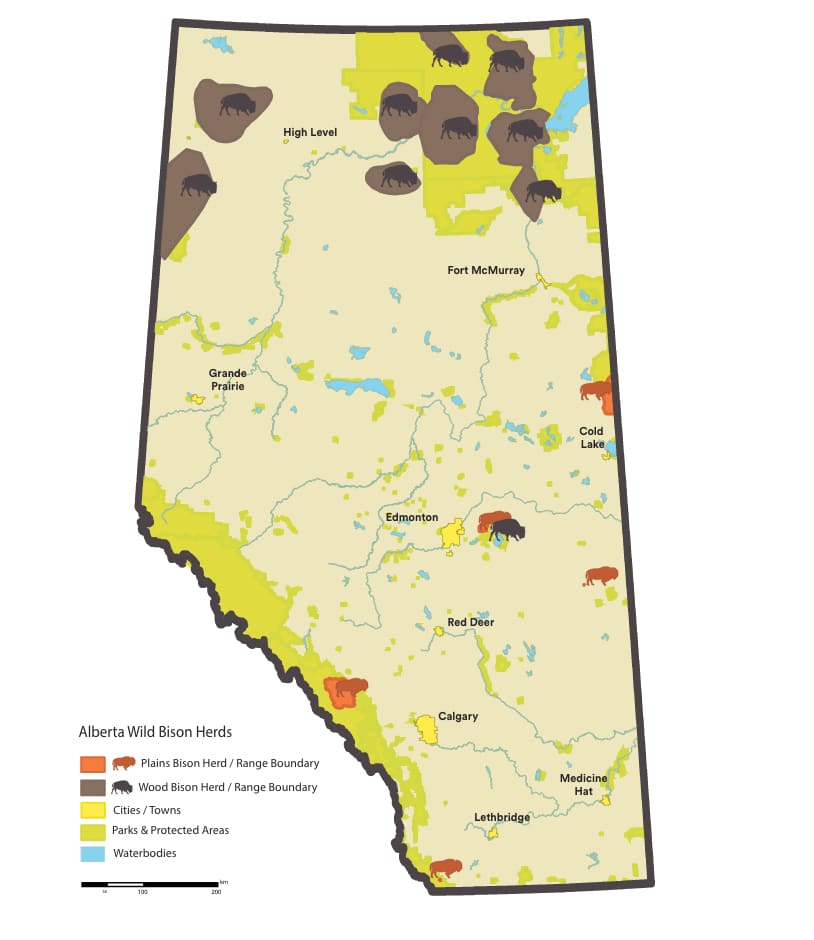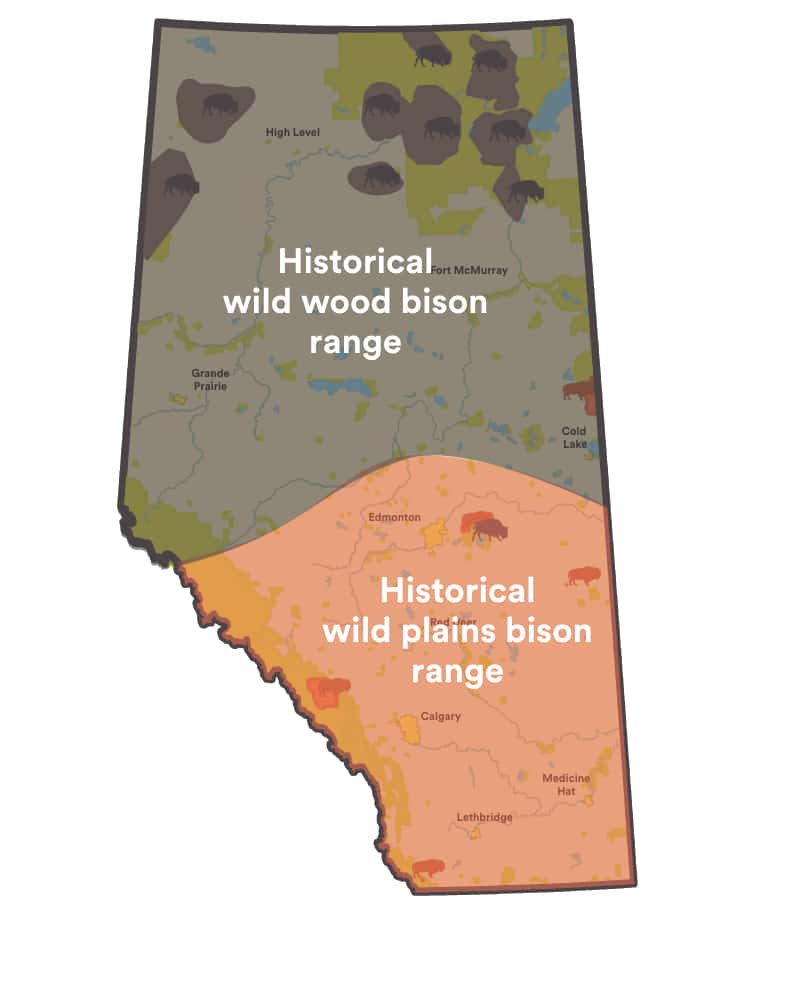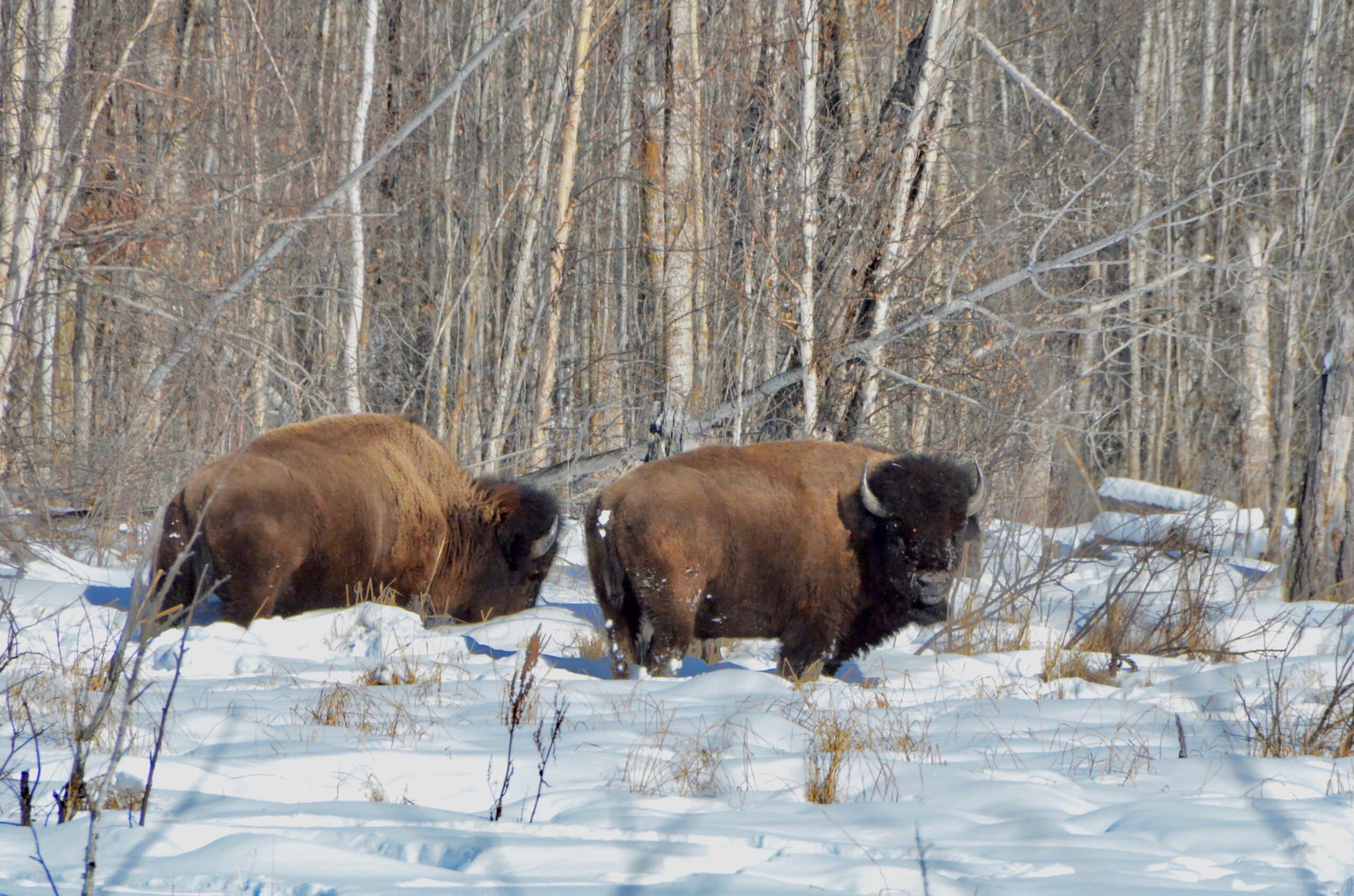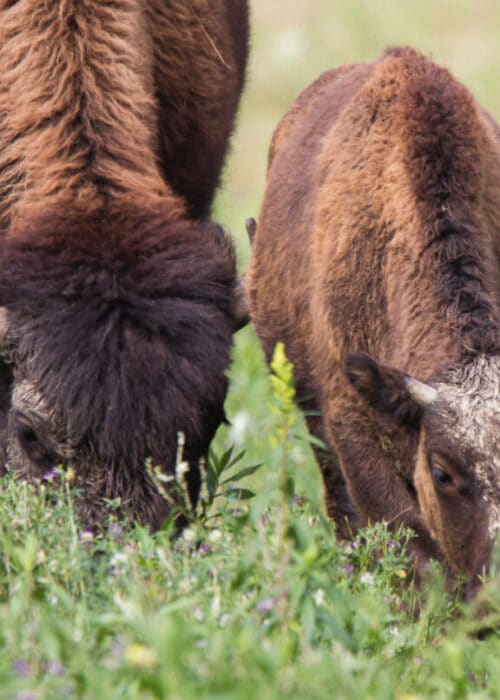In Alberta, strong conservation measures for bison on public lands are sorely needed. Bison are a critical part of boreal and prairie ecosystems and deserve long-term protection.
Bison are a part of Alberta's natural heritage
Wild bison are a fraction of their historical numbers.
In Alberta, there is a need to continue growing bison numbers and protect bison habitat. For decades, Indigenous communities and leaders, environmental groups, and experts have called for more protections for wild bison.
There are two subspecies of bison, also sometimes called “buffalo”, in Canada: wood bison and plains bison. Plains bison were once prolific, numbering more than 30 million in North America. They all but vanished by the late 1880’s in Canada due to over-exploitation, habitat loss, and disease. Their close cousins, the wood bison, also numbered more than 170,000 but dropped as low as 200 animals in the country.
Today in Alberta, due to massive conservation efforts, there are an estimated 2,800 free-ranging wild wood bison and about 700 wood bison in captivity. All of the plains bison in Alberta are semi-wild, captive, or farmed herds. Elk Island National Park houses roughly 500 semi-wild plains bison. These numbers are only a fraction of what our landscapes once sustained.
Though conservation efforts are ongoing, wild bison still face significant threats from habitat loss, bovine diseases, and unregulated hunting. Wood bison are considered ‘Threatened’ under Canada’s Species At Risk Act (SARA) and plains bison have been assessed as ‘Threatened’ by the Committee on the Status of Endangered Wildlife in Canada (COSEWIC).


stay Updated
Bison in Aberta
There is still time to stabilize and recover bison populations. With a strong focus on protecting bison habitat and supporting Indigenous-led initiatives, there can be a thriving future for this treasured species. Subscribe to our newsletter for the most up to date developments in bison conservation and opportunities to take action.
Alberta’s actions
Legal Protections for Wood Bison
As of November 2021, wild wood bison throughout northern Alberta will be recognized as a protected species and have been formally designated as ‘Threatened’ under the Alberta Wildlife Act.
Many Albertans would be shocked to learn that up until 2021, wild wood bison were not legally considered ‘wildlife’, but instead ‘livestock,’ as farmed bison are found throughout southern portions of the province. Without the ‘wildlife’ listing, harvesting of wild bison herds is unregulated, meaning imperiled bison could be harvested at any time, by anyone, anywhere.
Now, due to their ‘Threatened’ status, harvesting of wild wood bison in specified broad areas across northern Alberta is prohibited. Special Bison Protection Areas will also further protect disease-free wild herds. This update in protective status is still needed for the plains bison in Alberta.
Learn more about wood bison gaining ‘wildlife’ status here.
The national parks in Alberta are famous for their efforts to re-populate disease-free wild bison herds. Efforts on Alberta’s public lands need to match.
Elk Island National Park, Wood Buffalo National Park and more recently Banff National Park have all famously protected and grown within their borders using breeding or re-introduction programs. But more effort is still needed on provincial lands, where wild bison deserve habitat protection. Following the leadership of Indigenous communities, there is a bright future for recovering wild bison herds in the province. But as soon as these animals cross onto provincial lands, they are again at risk, as they become considered ‘stray livestock’. Compare this to co-management plans in Saskatchewan, where wild bison are collaboratively managed on federal and provincial lands.
Thanks to your help, more progressive protection measures can be taken to sustain wild bison herds. Sadly, plains bison remain without these same protections.
Threats to Bison
Habitat Degradation
Bison habitat is fragmented and existing herds are isolated from each other. Natural increases to wild population sizes is currently unlikely because habitat is fragmented and degraded, risk of road mortality during travel, poor disease management associated with livestock and commercial bison operations, and disease outbreaks.Low Populations
Wild herds are small and isolated, which means they are severely impacted by mortality events. For example, the Mackenzie bison herd in the Northwest Territories decreased by 53% due to an outbreak of anthrax, and the Hay Zama herd in Alberta was once tragically reduced by 20% due to starvation during a previous severe winter.
The unique genetics of small wild herds is also important to preserve, especially as few wild herds exist that are not made up of reintroduced animals from Elk Island National Park.
Unregulated Harvesting
Unregulated hunting has long been a strong threat to wild wood bison herds. Only recently, Alberta provided protections to wood bison to prohibit non-Indigenous hunting. Previously, harvesting was unregulated, except for two specific herds: the Ronald Lake herd and the Hay Zama herd.
To this day, the Hay Zama herd has a regulated hunt, which is regulated based on the size of the herd. The previous approach of applying management actions one-by-one did not meaningfully address bison conservation at the necessary broader scale.
Bovine Diseases
Alberta’s approach thus far for bison has been primarily focused on preventing the transmission of bovine diseases between herds: bovine tuberculosis and brucellosis. These diseases, which originated from farmed cattle, can quickly spread through a herd.
The few wild “disease-free” bison herds in the province are extremely valuable: the Ronald Lake herd, Hay Zama herd, and Wabasca herd. The Hay Zama is a reintroduced herd (with a reintroduction program that began in 1983), but the Ronald Lake and Wabasca herd are native to their herd ranges and naturally disease-free.
Sadly, many of the bison in Wood Buffalo National Park are considered diseased. It is critical to manage the spread of disease from infected herds in the park so they do not spread to uninfected wild herds around the park. Alberta focuses on limiting overlap between diseased bison herds, non-diseased herds, and farmed bison by keeping wild herds small. But, habitat conservation and protection can also be a helpful way to ensure disease-free herds do not shift their distributions at the risk of moving closer to diseased herds. CPAWS advocates strongly for habitat conservation and protection as a tool to prevent disease transmission.


Saving the Wabasca Herd from disappearing
In the southwest corner bordering Wood Buffalo National Park, there is a wood bison herd called the Wabasca herd. The herd is so small that it simply cannot sustain anymore hunting and is extremely vulnerable to more access by forestry roads. Ten years ago, there was an estimated 30-40 animals in the herd. Recent monitoring surveys have found as few as nine animals left in the herd.
This work is done following the leadership of the Indigenous-led ShagowAskee group, made up of Elders, trappers and knowledge holders from the Little Red River Cree Nation and Tallcree First Nation.
We need to act now before the Wabasca herd no longer exists.
CPAWS supports the call from trappers and Elders of the Little Red River Cree Nation and Tallcree Nation, a group called ShagowAskee, to protect the Wabasca wood bison herd habitat and improve management within their range, including the use of Indigenous Knowledge.
SAVE THE WABASCA HERD
Key Actions
Collaboration with Indigenous Communities
Alberta must complete a recovery plan specific to the Wabasca herd and must include collaboration with Indigenous communities.Protect Critical Habitat
“Critical habitat” must be identified so that it can be protected from destruction. Without identification of critical habitat, the Species At Risk Act (SARA) cannot be enforced. Critical habitat identification must include Traditional Knowledge about areas important to bison – including areas outside of where Alberta and Canada currently understand to be Wabasca herd range.Reopen Imminent Threat Assessment
Canada should consider re-opening an Imminent Threat Assessment (ITA) for Wabasca, given new threats from logging in areas Indigenous community members have identified as bison habitat.Pause Industrial Activities
Continued industrial activities that could impact the herd should be immediately paused, especially while the Wabasca sub-regional plan is not yet complete.Plains Bison
Securing Protective Measures
Plains bison occupy less than 1% of their historic range in Canada. While wood bison have been officially designated as a ‘Threatened’ species in northern Alberta, their close counterpart, the plains bison, does not share this protected status. Plains bison require conservation measures, just the same as wood bison do. CPAWS Northern Alberta will continue to explore potential to list plains bison as a threatened species in Alberta, and listed federally on Canada’s Species At Risk Act (SARA).
Learn more
Wildlife & Species At Risk
The Biodiversity Crisis has put into jeopardy the future of many of Alberta’s most beloved species. Rapid declines in species populations, with some being pushed to extinction, tell us loud and clear that the ecosystems that these species call home need protection.
Make a donation
Move conservation forward in Alberta.
Lasting protection for nature and wildlife in Alberta doesn’t happen overnight (although we wish it did)! Your donation fuels our fight for nature. Donate to support CPAWS Northern Alberta’s conservation efforts.
